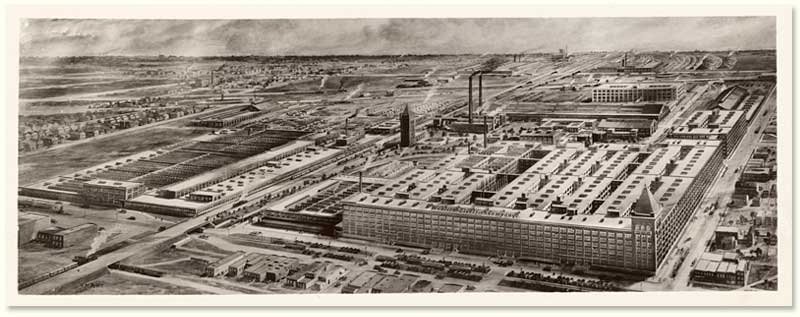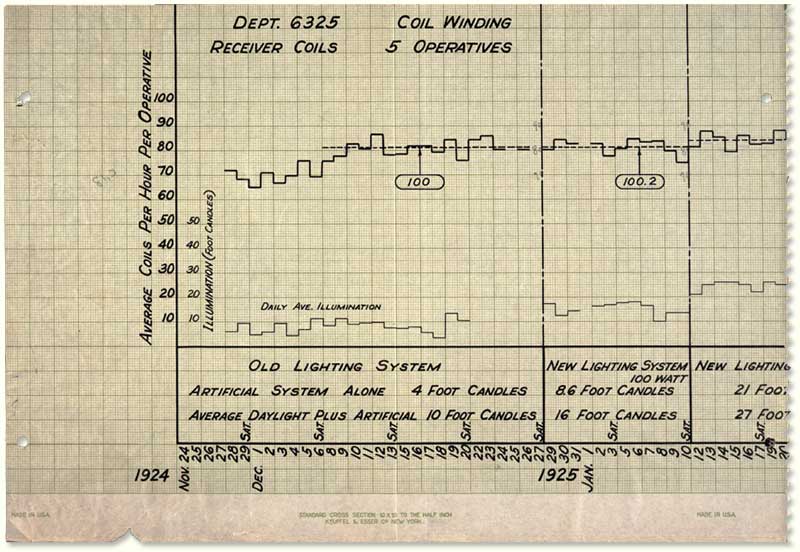The Hawthorne Studies
This chapter is based on the article The Hawthorne studies and their relevance to HCI research, interactions 21, 6 (October 2014), 46-51.
 Aerial view of the Hawthorne Works, ca. 1925.
Aerial view of the Hawthorne Works, ca. 1925.
Introduction
The Hawthorne studies are best known for the Hawthorne effect, namely that those who perceive themselves as members of the experimental or otherwise favored group tend to outperform their controls, often regardless of the intervention. Secondary sources describing the Hawthorne effect (e.g., [1,2]) tell us that in an experiment conducted at Western Electric’s Hawthorne Works factory in the 1920s, psychologists examined the working conditions of plant workers doing repetitive tasks. The major finding quoted is that irrespective of what one does to improve or degrade conditions, productivity goes up. The usual example given is variation in light. If light conditions improved, so did productivity; however, when light conditions were downgraded, productivity again went up.
Unfortunately, this oversimplified story about the Hawthorne effect overshadows the groundbreaking contribution of the Hawthorne studies. The Hawthorne effect is not only controversial [1]—it’s also probably the least interesting and least relevant result of this landmark study. The famous light experiment at the Hawthorne plant was just one of more than 30 experiments involving repetitive workers (e.g., relay assemblers, mica splitters) as well as supervisors and other decision makers [3]. And the results were not quite as simple as secondary sources may suggest.
Here, I want to call attention to some of the breakthroughs credited to the Hawthorne studies, which have made a number of practical, conceptual, and methodological innovations in human factors, management studies, and sociology. I also want to argue that even though these studies were performed more than 80 years ago, the HCI research community can still learn something from them.
The Hawthorne Studies
The Hawthorne studies were conducted at Western Electric’s large plant outside Chicago. The research outcomes are reported in Roethlisberger and Dickson [4]. I would also recommend Jeffrey Sonnenfeld’s detailed analysis of the studies and their influence [5], as well as the online resources at the Harvard Business School [6].
In a period between 1924 and 1933, six studies were performed. These studies were longitudinal in nature, running between several months and several years.
The Illumination Studies (1924). The studies began in 1924 when researchers, together with the National Research Council of the National Academy of Sciences, tried to examine the relationship between light intensity and employee productivity at the Hawthorne Works plant. The expectation was that an increase in lighting would lead to an increase in productivity, and vice versa. But an impressive team of industrial specialists and academics was not able to find any consistent correlation between lighting levels and worker output. The productivity increased with brighter intensity, but also with lower intensity, as well as when researchers only pretended to increase or decrease the intensity of light. No further tests were planned originally, but researchers were puzzled by these unanticipated results. They realized there was not a simple answer to the issue of illumination and worker productivity. The psychological and sociological issues, which were not controlled, presented a major problem with the test results.

At this point, the National Research Council withdrew from the project. However, Western Electric decided to continue studies in collaboration with Harvard University researchers, including Fritz Rothlisberger, W. Lloyd Warner, and Elton Mayo. They also changed the research objective from a study of illumination to a study of the physical factors that cause fatigue and monotony.
The Relay Assembly Test Room (1927–1932). In the next research phase, five workers assembled magnetic relays, working in isolation from the main shop. The separation was chosen to better control working conditions and to more deeply investigate productivity. Researchers collected and analyzed a significant amount of data, including mechanical records of worker output, a daily record of comments made by researchers and study members, observers’ logs of work activity, results of periodic medical examinations of workers, and interview transcripts.
This research phase lasted five years, but experimental conditions were maintained for only the first two and a half years. Thirteen experimental treatments took place, including variations in the number and duration of rest breaks, the length of workdays, and the length of workweeks. Throughout the studies, production steadily rose. At the end, when the original, more demanding conditions were reinstated, the productivity of workers dropped only slightly, to a 30 percent increase over the original output. In addition, absenteeism dropped to a third of the original absenteeism. Evidence to support the initial hypotheses about relief from fatigue and monotony was inconclusive.

Two derivative studies (1928–1929). Because researchers were unsure what caused the significant increase in productivity in the Relay Assembly Test Room, they launched two derivative studies. These explored two possible explanations for improvements in productivity. One explanation was the different incentive systems. Researchers realized that in the Relay Assembly Test Room, workers in a smaller group could more directly affect their group-based compensation, compared with 200 assembly workers in the main shop. A new relay group with a small-group-output incentive plan was arranged on the shop floor, but without being isolated from the other workers. Productivity quickly increased by 12 percent but leveled off for the duration of the study.
The second derivative study was performed to test the effect of isolation of a small group on productivity. A group of workers did not receive a different incentive plan but were placed in a separate room. Group output increased in the early phase of this project by 15 percent. However, the investigators also realized that external factors had a much more significant effect on productivity than any of their interventions. For instance, when rumors about the possible transfer of some jobs away from Hawthorne appeared, productivity began to drop significantly.
The conclusion from the derivative studies was that the wage incentive had some role in the productivity increase, but that it certainly did not completely explain the productivity increase in the Relay Assembly Test Room. Furthermore, the investigators concluded that it was not possible to identify the independent influence of wage incentives on productivity because it is so intertwined with other variables.
Interview program (1928–1930). The management and investigators were impressed with the great potential of workers if they were given proper conditions. But they were uncertain about what these conditions might be. For that reason, from 1928 to 1930 they interviewed around 21,000 employees. The interviews were then analyzed and classified by the articulated complaints.
Interviewers made a number of interesting findings. But they also quickly discovered that it was not enough to simply catalog complaints. Management was aware of many of the complaints, but out of context, complaints were misleading. However, understanding the personal and economic background of the workers made possible a much richer appreciation of the importance of a given complaint.
The interview program also suggested there was a great motivational value in directly asking workers for their opinions and perceptions and listening closely to their responses, as well as recognizing the relationships between workers’ work and non-work lives.
Bank Wiring Observation Room (1931–1932). Hawthorne investigators also observed the relative social positions of different jobholders in a group. In the Bank Wiring Observation Room, the last research phase in the Hawthorne studies, investigators looked at 14 workers in three different jobs. They worked together to produce wired equipment for use in switches. The goal was to investigate the status distinctions and social relations in the workplace. The researchers discovered an unexpected culture, revealed through group norms and activities such as informal leadership patterns, restriction of output, group discipline, friendship, job trading, and cooperation. In this final research phase, the investigators developed hypotheses about the conditions that encourage the creation of an informal culture, which may be either compatible with or hostile to managerial intentions.
The Legacy of the Hawthorne Studies
It is easy to see the Hawthorne studies as a failure. None of the findings obtained were very conclusive, and the studies were also imperfect from a methodology point of view. Critiques were often harsh, with results being called “injudicious,” “scientifically worthless,” “the myths of Hawthorne,” and the result of “cow sociologists” [5].
Sonnenfeld, however, noted that many critiques of the Hawthorne studies were incorrect and out of context, claiming that “the gunsmoke of academic snipers can obscure the conceptual contribution of these pioneering efforts” [5]. He elaborated that the Hawthorne studies were conducted in a manner that led not to the testing of theories, but to their development. Consequently, their greatest contribution was to expand the concepts of organizational behavior beyond Frederick Taylor’s notion of scientific management. At that time the prevailing view was that people went to work purely for money and to earn a living. The Hawthorne studies showed convincingly that this view was deeply flawed. “Instead of treating the workers as an appendage to ‘the machine,’” Sonnenfeld noted, the Hawthorne studies brought to light ideas concerning motivational influences, job satisfaction, resistance to change, group norms, worker participation, and effective leadership [5]. In the 1930s, these were groundbreaking concepts. Under the influence of the Hawthorne studies, management teaching and practice changed significantly. The Hawthorne research stimulated thought on individual differences and job matching, work design, incentive plans, employee participation, the social nature of organizational activities, small work groups, and leadership. The findings from the studies have been credited with contributing to the later development of social science topics, including small-group behavior, client-centered theory, organization theory, and research methodology.
Porter, Lawler, and Hackman noted that the Hawthorne investigators were the first to highlight the social complexities of organization life:
“From the time of the publication of the results of the Hawthorne Studies onward, no one interested in the behaviour of employees could consider them as isolated individuals. Rather, such factors and concepts as group influences, social status, informal communication, roles, norms, and the like were drawn upon to explain and interpret the voluminous data from these studies and other field investigations that followed them.” [7].
As a consequence, in social and management research, the study of static social structures practically disappeared after the publication of the Hawthorne research.
The Hawthorne studies significantly contributed to the development of research methodology for studying complex social situations. Hawthorne investigators were initially convinced that controlled experiment was the best methodology for their research. Through the studies they made a significant methodological shift, in which they recognized the impossibility of applying the controlled experiment approach for the questions they were addressing. Roethlisberger and Dickson summarize this shift:
The difficulty, however, went much deeper than the personal feelings of failure of the investigators. They were entertaining two incompatible points of view. On the one hand, they were trying to maintain a controlled experiment in which they could test for the effects of single variables while holding all other factors constant. On the other hand, they were trying to create a human situation, which remained unaffected by their own activities. It became evident that in human situations not only was it practically impossible to keep all other factors constant, but trying to do so in itself introduced the biggest change of all; in other words, the investigators had not been studying an ordinary shop situation but a socially contrived situation of their own making.
With this realization, the inquiry changed its character. No longer were the investigators interested in testing for the effects of single variables. In the place of a controlled experiment, they substituted the notion of a social situation, which needed to be described and understood as a system of interdependent elements* [4].
Individual human behavior is determined by a complex set of factors and is rarely a consequence of a simple cause-and-effect relationship.
The Relevance of the Hawthorne Studies for Computer Science Research
Those who cannot remember the past are condemned to repeat it.—George Santayana
The story of the Hawthorne studies is in many ways similar to the story about the development of the many computer science (CS) fields. Liam Bannon, for example, observed that the HCI (human-computer interaction) discipline has moved from early studies of human factors and experimental evaluation of interfaces toward the general sense-making of our world:
The area of concern [of HCI] is much broader than the simple “fit” between people and technology to improve productivity (as in the classic human factors mold); it encompasses a much more challenging territory that includes the goals and activities of people, their values, and the tools and environments that help shape their everyday lives [8].
In other words, HCI is much more than efficient user data input or output. Solutions to HCI problems do not reside in simple ergonomic corrections to user interfaces. Hawthorne investigators drew similar conclusions about working conditions, namely that simple ergonomic corrections, such as changing the light intensity, are not sufficient to improve productivity and are certainly not the most significant factors that influence productivity.
Another reason the Hawthorne studies are relevant for CS research is methodological. Investigators made a shift from controlled experiments toward approaching a complex social situation as a system of interdependent elements. In many ways, this shift is what we experience today in HCI and interaction design communities. Bannon, for example, argued that the introduction of the computer supported cooperative work (CSCW) field presented “a shift from a psychological to a sociological perspective on human work and activity, emphasizing field observation methods rather than lab studies” [8]. The Hawthorne studies provide an illustration of why such approaches are needed when studying complex human and social phenomena.
Furthermore, the studies showed the value of careful observation and honest reporting of research failures and successes. As noted by Jonathan Arnowitz and Elizabeth Dykstra-Erickson, “[t]he great value of the Hawthorne experience is in learning to observe and keep on observing, especially when an initial causal relationship doesn’t quite account for the observed interaction” [2]. In many situations Hawthorne researchers were confused, and they admitted it. But they continued to carefully observe and document all of their findings. The original elaborate report of the studies, Management and the Worker [4], is a model of honest reporting of research. It describes, in a chronological order, the things investigators did, the judgments they made, the leads they followed, and the conclusions they drew. Roethlisberger and Dickson selected this method to “picture the trails and tribulations of a research investigator at his work and thus allow future investigators to see and profit from the mistakes which were made” [4]. This approach makes Management and the Worker, even after 75 years, a relevant and surprisingly insightful book, useful for anyone who wants to understand the difficulty of studying realistic complex human issues in realistic situations. I would recommend it as standard reading for CS researchers.
The Hawthorne studies also demonstrated the value of doing research in practice, over a long period, and with real users and realistic tasks. A related issue is the fact that the Hawthorne studies produced useful results primarily because of the interest and support of Hawthorne Works. While researchers from the academy were involved, the main initiative did not come from the academic side or from funding agencies (the National Research Council of the National Academy of Sciences withdrew after the initial “failure” of the illumination test). I think this may be an important lesson for the HCI community. It suggests that lasting and robust research contributions related to real-world human issues may be those based on inquiry from within industry rather than those initiated by academia and commissioned by funding bodies.
Lastly, the Hawthorne studies illustrated that the value of research is not necessarily derivation of conclusive results. The legacy of these studies is a realization that treating the workers as an “appendage to ‘the machine’” with the goal of improving the human-machine “fit” is a flawed conceptual framework [5]. This legacy may stimulate us to look differently at some HCI contributions. Similar to the Hawthorne studies, the lasting impact of some HCI research may be not the results of laboratory experiments, but rather an expansion of the concepts of HCI beyond notions of human-computer “fit” and the identification of new concepts that can help us to understand human activities mediated by computing.

The last remaining portion of Western Electric’s Hawthorne Works factory.
References
-
Macefield, R. Usability studies and the Hawthorne Effect. Journal of Usability Studies 2, 3 (2007), 145–154.
-
Arnowitz, J. and Dykstra-Erickson, E. Observation and interaction design: Lessons from the past. Interactions 14, 6 (Nov. 2007), 64–ff.
-
Brown, A.L. Design experiments: Theoretical and methodological challenges in creating complex interventions in classroom settings. The Journal of the Learning Sciences 2, 2 (1992), 141–178.
-
Roethlisberger, F.J. and Dickson, W.J. Management and the Worker. Harvard University Press, 1939.
-
Sonnenfeld, J.A. Shedding light on the Hawthorne Studies. J. Occupational Behavior 6, 2 (1985), 111–130.
-
http://www.library.hbs.edu/hc/hawthorne/
-
Porter, L.W., Lawler, E.E., and Hackman, J.R. Behaviour in Organizations. McGraw-Hill, New York, 1975.
-
Bannon, L. Reimagining HCI: Toward a more human-centered perspective. Interactions 18, 4 (2011), 50–57.